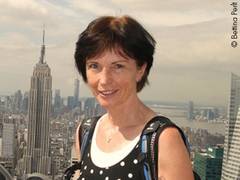The Faster the Better - Velocity in Pole Vaulting
Measuring Run-up Velocity in Pole Vaulting
Dr. Bettina Perlt
Pole vaulting is one of the most technically challenging disciplines in track and field. It is the only jumping discipline in which the result – in this case, the height cleared – can be influenced by the athlete even after the jump.
However, before the athlete can transition into vertical ascent, s/he must first carry out the horizontal approach with a pole in hand. First, the pole is carried raised up in front of the body, the tip is then lowered, and the bottom of the pole finally planted into the vault box. The athlete jumps up with his/her trail leg leaving the ground last, rolls him or herself up-right after achieving the C position with the pole, and crosses over the bar by stretching and subsequently turning his/her body.
The approach is one of the key elements. Reaching the fastest run-up velocity possible is a crucial prerequisite for achieving peak height in pole vaulting. More than 80% of the energy requirement is produced during the approach (Czingon, 2004). The goal is to pro-vide the body’s center of gravity with as much kinetic energy as possible at the beginning of the ascent, which is then converted to potential energy throughout the remaining part of the jump (Schade, 2012).
In the 1960s, the predecessor institute of the IAT carried out measurements to determine the run-up velocity in pole vaulting with the help of optoelectronic methods (light barriers). This method was used internationally in World Championships and the Olympic Games.
The positions of the double light barriers have remained the same since 1990:
for men at 16 m, 11 m, and 6 m and for women at 15 m, 10 m, and 5 m before the back wall of the vault box. For boys and for decathlon 15.5 m, 10.5 m, and 5.5 m are valid.
In 1993, IAT began recording run-up velocities using the LAVEG from JENOPTIK GmbH. With the infrared laser the distance of the athlete to the apparatus is recorded at a time in-terval of 0.02 s. Thus, 50 measurement values can be achieved per second. The athletes run up to a measured zero position (back wall of the vault box). Through interpolation the times are determined exactly for the positions, at which the light barriers are otherwise lo-cated. From this time difference, the average velocity can be calculated for each of these two measurement sections.
Measurements of the run-up velocity were carried out at IAT following the observation of several competitions. The statistical correlation between run-up velocity and height cleared has been repeatedly proven since 1966 (Adamczewski & Dickwach, 1991; Adamczewski & Perlt, 1997, 2007; Linthorne & Weetman, 2012). One could say that for every 1 m/s of higher run-up velocity, a half meter of height can be cleared per jump. And yet the velocity is only one of the performance-defining factors.
Figure 2 shows the strong correlation between the take-off velocity and the height cleared at a German Youth Championship. You can see that the first-place pole vaulter is in the upper right-hand corner of the scatter diagram, which means that a higher run-up velocity was achieved. It shows that deviations are possible, which begs the question of whether the athlete who placed sixth cannot in general run any faster (i.e., insufficient running speed) or he can run fast but cannot transfer this advantage to the pole (insufficient arm strength and/or technique).
The LAVEG measurements provide additional information on the velocity curve.
Dr. Bettina Perlt (1956) obtained her graduate and doctoral degree in physics at Karl Marx University in Leipzig.
In 1982 she began working in the biomechanics laboratory of the Research Institute for Physical Culture and Sport (Forschungsinstitut für Körperkultur und Sport (FKS)) in Leipzig. Since its founding in 1992, she has been working at the Institute for Applied Scientific Training (Institut für Angewandte Trainingswissenschaft (IAT)) as a research associate in the group specializing in throw/shot in the department specializing in power training. She analyzed pole vaulting for more than 20 years and developed the MIS* pole based on the analysis of several competitions.
She is currently working on new and further MIS developments for shot put, the javelin, discus, and hammer. Synchronized video clips and dynamometric measurements are recorded and stored in a database. The analyses of the measurements and video recordings form the basis of sound scientific training recommendations for trainers and athletes.
*MIS: Measurement and information system
Further product information:
Avalanche Photodiodes
Pulsed Laser Diodes
Contact:
| Contact Person: | Winfried Reeb |
| Company: | Laser Components Germany GmbH |
| Address: | Werner-von-Siemens-Str. 15 |
| ZIP / City: | 82140 Olching |
| Phone: | +49 (0) 8142 2864-42 |
| Fax: | +49 (0) 8142 2864-11 |
| Email: | winfried.reeb@lasercomponents.com |
| |
|


Subscribe to Photonics News
Would you like to keep yourself up to date on our products and services? Subscribe here to the German language version of our free Photonics News E-Mail-Newsletter and stay up to date.


























































